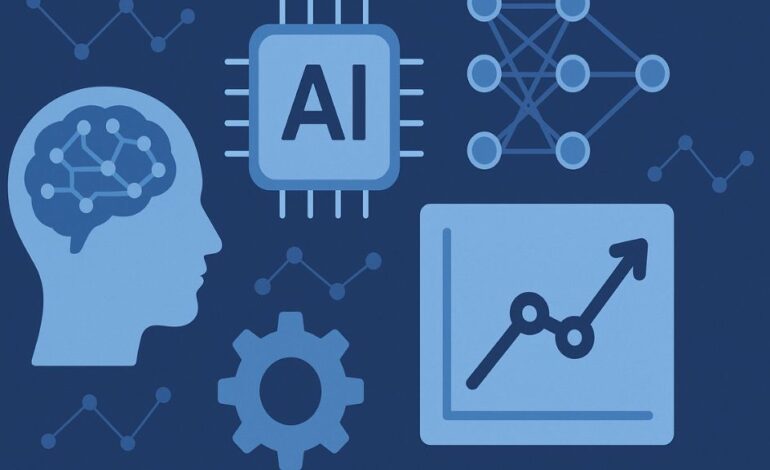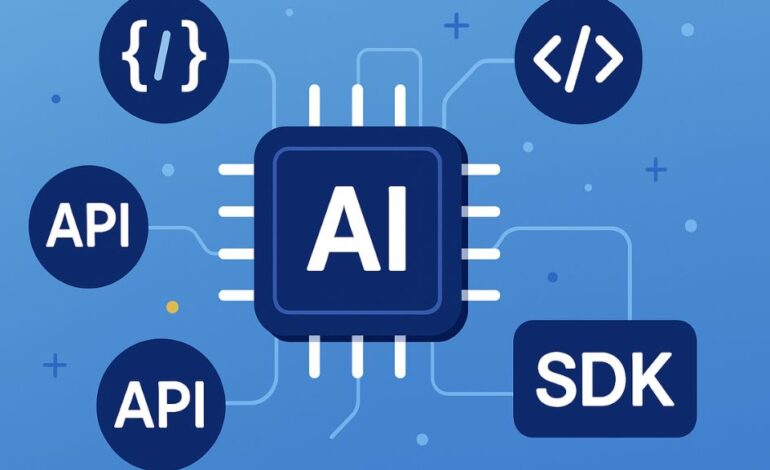
Table of Contents
ToggleArtificial Intelligence (AI) and Machine Learning (ML) are redefining what’s possible across every industry—from healthcare and finance to marketing and logistics. But with a crowded market, selecting the right platform is critical for maximizing results and accelerating innovation. This in-depth guide reviews the 20 best AI and machine learning platforms in 2025, each tested for usability, flexibility, and real-world value. Whether you’re an enterprise scaling AI, a developer building prototypes, or a startup launching intelligent products, these platforms are your key to future-ready solutions.
Best AI And Machine Learning Platforms in 2025
Google Cloud AI Platform
Best for: Natural Language Processing (NLP)
Google Cloud AI Platform delivers a full-stack solution for building, training, and deploying machine learning models. Its suite includes AutoML, custom model support, and pre-trained APIs for vision, speech, and language, making it a favorite among businesses looking for powerful, production-ready AI.
With seamless integration to Google Cloud services and industry-leading security, Google Cloud AI Platform empowers organizations to rapidly launch advanced ML projects. The platform also provides explainable AI tools and managed notebooks for team collaboration. It’s a strong choice for companies that need scalable, customizable solutions with the reliability of Google’s infrastructure.
Amazon SageMaker
Best for: End-to-end machine learning
Amazon SageMaker is a managed service on AWS designed for building, training, and deploying machine learning models at scale. SageMaker supports popular ML frameworks, automated model tuning, and real-time predictions, streamlining the ML lifecycle from data labeling to deployment.
The platform’s built-in Jupyter notebooks and collaboration tools allow teams to iterate quickly. With support for MLOps, model monitoring, and cost-efficient training, SageMaker stands out as a robust choice for businesses ready to scale their ML workloads on AWS’s powerful infrastructure.
Microsoft Azure Machine Learning
Best for: Enterprise solutions
Azure Machine Learning Studio provides a collaborative environment for data scientists and ML engineers to develop, train, and deploy AI solutions. Its drag-and-drop designer and automated ML features simplify complex workflows, making ML accessible even to non-coders.
Integrated with Azure DevOps and enterprise security, the platform supports large-scale deployment, continuous integration, and easy collaboration. For companies leveraging Microsoft’s cloud ecosystem, Azure ML offers unmatched convenience, scalability, and business continuity.
IBM Watson Studio
Best for: Collaborative AI development
IBM Watson Studio offers a comprehensive platform for data scientists and business analysts, featuring AutoAI for automated model building and robust governance tools for model management. Watson Studio supports open-source languages and seamless collaboration among teams.
With enterprise-grade security, integration with IBM Cloud Pak, and lifecycle management features, Watson Studio empowers organizations to operationalize AI at scale. Its explainability and bias detection tools help maintain compliance and transparency for AI-driven decisions.
TensorFlow
Best for: Deep learning and neural networks
TensorFlow is an open-source powerhouse for building, training, and deploying deep learning models. Known for its flexibility, it supports everything from prototyping research projects to running large-scale production pipelines.
With GPU acceleration, mobile deployment via TensorFlow Lite, and a huge community of contributors, TensorFlow enables rapid experimentation and innovation in AI. The framework’s extensive documentation and ecosystem make it ideal for anyone building state-of-the-art neural networks and deep learning applications.
PyTorch
Best for: Research and production environments
PyTorch is a leading deep learning framework renowned for its dynamic computation graph and intuitive interface. It’s particularly popular in academia, powering much of today’s AI research and breakthroughs.
The strong ecosystem, robust debugging tools, and ONNX export for production deployment make PyTorch the go-to for researchers and companies alike. Its support for GPU and mobile deployment allows for scalable and flexible applications in both experimentation and production.
Hugging Face
Best for: NLP and transformers
Hugging Face has revolutionized NLP with its massive library of pre-trained transformer models, including BERT, GPT, and T5. Its intuitive platform enables fast prototyping, fine-tuning, and deployment of cutting-edge language models.
Developers and data scientists can access more than 200,000 models for text, vision, and audio tasks, supported by a vibrant community and cloud-hosted APIs. Hugging Face makes state-of-the-art NLP accessible for both small startups and large enterprises.
Kubeflow
Best for: Scalable ML workflows
Kubeflow is an open-source platform designed to run ML workloads on Kubernetes. It orchestrates everything from data preprocessing to model deployment, making it easy to build end-to-end ML pipelines.
The platform supports multi-cloud and hybrid environments, offering hyperparameter tuning, automated scaling, and experiment tracking. Kubeflow is a favorite for organizations looking to standardize and scale their ML operations across complex infrastructures.
DataRobot
Best for: Automated machine learning
DataRobot simplifies AI by automating the full ML lifecycle, from data preparation to deployment. Its AutoML engine delivers best-in-class predictive models with little to no coding required.
With features like explainability, real-time collaboration, and model governance, DataRobot empowers business analysts and data scientists to create enterprise-grade models quickly and efficiently, making AI more accessible than ever.
RapidMiner
Best for: Predictive analytics
RapidMiner offers a code-free, visual platform for predictive analytics and data science. Users can build sophisticated ML models using drag-and-drop workflows, making machine learning accessible to a wider audience.
With real-time scoring, automated data preparation, and strong community support, RapidMiner accelerates model development for organizations needing actionable business intelligence—without the need for coding expertise.
KNIME Analytics Platform
Best for: Data science workflows
KNIME is an intuitive, open-source platform for building end-to-end data science workflows with its modular, visual programming interface. Data integration, model building, and reporting are all streamlined through its drag-and-drop nodes.
KNIME’s strong Python and R integration allows users to mix code and no-code components, making it ideal for both business analysts and data scientists. Extensive extensions and connectors further expand its capabilities.
Databricks
Best for: Unified data and AI
Databricks combines the power of data engineering, machine learning, and analytics into a single cloud-native platform. It’s built around Apache Spark and Delta Lake for scalable and reliable big data processing.
Data scientists benefit from collaborative notebooks, automated ML, and seamless workflows that allow fast experimentation and deployment, making it perfect for teams managing large-scale data and AI projects.
AutoGluon
Best for: Fast prototyping
AutoGluon from AWS democratizes AutoML, allowing even non-experts to build high-quality models for images, text, and tabular data with minimal coding. The library streamlines model selection and hyperparameter optimization.
It’s an ideal solution for rapid prototyping and experimentation, giving teams production-ready ML models quickly, and is particularly useful for startups and researchers aiming for speed and flexibility.
Fast.ai
Best for: Deep learning education
Fast.ai’s PyTorch-based library makes deep learning more accessible for everyone, from students to researchers. It offers practical, high-level APIs, transfer learning, and a strong focus on teaching.
With an active community and plenty of real-world tutorials, Fast.ai is perfect for those looking to break into AI and deep learning without a steep learning curve.
Clarifai
Best for: Visual recognition
Clarifai offers powerful APIs and tools for image and video recognition, enabling businesses to leverage AI for object detection, moderation, and visual search. Its platform supports custom model training and scalable deployment.
With a no-code AI builder and robust RESTful APIs, Clarifai is suited for developers, enterprises, and industries ranging from retail to security.
Paperspace Gradient
Best for: Cloud-based machine learning
Paperspace Gradient enables users to run demanding ML workloads on powerful cloud GPUs without managing hardware. Its Jupyter-compatible notebooks make it simple to collaborate and scale projects.
With built-in versioning, CI/CD, and GPU spot instances, Gradient accelerates research and development for ML teams seeking affordable, high-performance cloud infrastructure.
Modzy
Best for: Enterprise AI models
Modzy is designed for enterprises that need secure model management and deployment. It offers monitoring, explainability, and compliance features to help organizations operationalize AI safely.
With support for audit trails, model versioning, and a marketplace of pre-built models, Modzy is ideal for regulated industries seeking to unlock AI at scale without sacrificing governance.
MLflow
Best for: End-to-end ML lifecycle
MLflow is an open-source platform for managing the full ML lifecycle: tracking experiments, packaging code, and deploying models. Its model registry and multi-framework support allow seamless handoff between teams.
As an extensible tool, MLflow is perfect for organizations standardizing machine learning processes and seeking reproducibility, transparency, and efficiency in their workflows.
Vertex AI (Google)
Best for: Unified AI development
Vertex AI, Google’s next-generation AI platform, integrates AutoML and custom model development into a single service. Its seamless connection to Google Cloud data sources simplifies data ingestion, training, and serving.
The platform provides model monitoring, explainable AI, and robust MLOps, empowering teams to move from experimentation to production faster than ever.
Oracle Cloud Infrastructure Data Science
Best for: Enterprise machine learning
Oracle Cloud Infrastructure Data Science provides a collaborative and secure environment for building, deploying, and managing ML models. Its integration with Oracle’s cloud ecosystem makes it a natural choice for businesses already using Oracle.
With features like a model catalog, version control, and automated resource scaling, Oracle Data Science is built for enterprises that require reliability, governance, and efficiency.
Why Choose AI & Machine Learning Platforms?
AI & ML platforms are not just for tech giants—they help businesses of any size:
- Accelerate development and deployment of intelligent applications
- Access the latest research and algorithms without reinventing the wheel
- Scale solutions as your data and business grow
- Reduce costs with pay-as-you-go models and automation
- Increase competitive advantage through data-driven insights
Recommendations
- For NLP & text: Hugging Face, Google Cloud AI Platform
- For Deep Learning: TensorFlow, PyTorch, Fast.ai
- For No-Code / Low-Code: RapidMiner, KNIME, DataRobot
- For End-to-End Cloud ML: Amazon SageMaker, Azure ML, Vertex AI
- For Visual Recognition: Clarifai
- For Enterprises: IBM Watson Studio, Modzy, Oracle Cloud Data Science
FAQs
What is an AI & Machine Learning Platform?
It’s a software environment that offers tools and services for building, training, deploying, and managing AI/ML models—streamlining workflows and accelerating innovation.
Who should use these platforms?
Data scientists, software developers, businesses, startups, and enterprises looking to build or scale AI solutions.
Are there free AI/ML platforms?
Yes! Many platforms like TensorFlow, PyTorch, KNIME, and MLflow are open source. Most commercial platforms also offer free tiers.
How do I choose the right platform?
Assess your project requirements—consider data size, model complexity, team expertise, integration needs, and budget.

